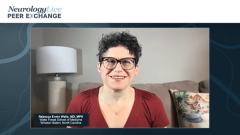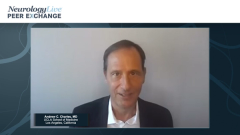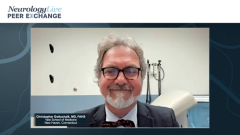
Measuring Success in Migraine Preventative Treatment
A discussion on how to measure the success of preventative migraine treatment.
Episodes in this series

Jessica Ailani, MD: How do we set goals for a patient? Or how are goals set for the patient? How do we really measure this?
I want to open this question up to anyone who wants to go first. With a patient, how do you evaluate individual success? Rebecca, if you wanted to go first and say a few words about this.
Rebecca Erwin Wells, MD, MPH:This is such a great question and there are so many measures that we can look at and quantify, but I think the most important thing is asking the patient what is most important to them and how they perceive their headaches. I have a lot of medical students, residents, and trainees working with me and the first thing I tell them when I have them go in and see a patient is to ask the patient not only about their headaches but how they think they’re doing. This often happens because you can walk into a patient’s room and they say, “I’m having headaches every single day” and in your head you’re thinking, “Oh this isn’t so good.” Then the patient may say, “But I used to have migraine attacks every single day,” and so the patient is actually happy that they’re not having migraine attacks every day.
Then you can walk into the next patient’s room and they say, “Oh, I’m having 6 migraine attacks a month.” After having just been in the other patients’ room you think, “Wow, not so bad.”But they’re like, “It’s horrible, it’s ruining my life.” I think as providers, especially when you see patients frequently with headache, I think it is understanding the perception of the patient in terms of their burden, their disability, and how it affects their life. How many times do we see patients in the clinic and you look at the numbers ,and you think. “Wow, we’ve decreased their headache frequency by 50%, we’re doing great.” And you go in and you say, “How are we doing?” And they are like, “Horrible, not good at all.”
Often what happens is they had a migraine the day before your visit and they’re remembering the experience of that individual attack. But even with that information, I think it’s important to recognize and understand what is going on with the patient and how they perceive what they’re experiencing.
Jessica Ailani, MD:That I think is an absolutely excellent point, it is that immediate memory too, and then trying to wrap it in an overall experience. Anyone else? Does anyone use any measures like any of these tools that are often for research? Andy?
Andrew C. Charles, MD: We usually use a number of metrics. Especially the functional metrics, of MIDAS, [Migraine Disability Assessment Scale] or HIT-6, [6 item Headache Impact Test] and those sort of new measures of disability and function. Although, honestly we don’t use them as much as they are used in clinical research studies. It really comes back to what the others were saying about really individualizing the response based on the individual patient rather than from some uniform metric.
The other question that I like to ask that’s a little bit different, and it’s partly something I’m asking now because people are responding more affirmatively with the new therapy is, how often do you have a crystal-clear day? A day where you just feel normal, you’re functioning well, you’re not thinking about migraine, you’re not having any cognitive dysfunction, or fatigue, or nausea, or light sensitivity, or anything else.That’s something that, especially of course, for those with chronic migraine, but even for those with high frequency episodic migraine will often respond if they’re not well treated that they don’t even have 1. To get people to the point where they know what it’s like to feel that kind of clarity and normalcy, for me is really an important message.
Stefanie J. Nahas, MD, MSEd, FAHS, FAAN: I agree 100% with what everybody has been saying, that it has to be individualized, it has to be really driven by the patient’s values and desires. But another thing that I would say in terms of success and measuring it and defining it is that you have to set some realistic expectations and maybe have a plan for some step-wise achievements towards a loftier goal, because we’ve all had patients who were so disappointed when they came back 2 or 3 months after starting a new preventive agent, and they weren’t yet at 50% fewer headache days. Or even that they thought this preventive treatment is going to prevent all of their headaches and they should be cured by the time they come back.
Now, this is becoming a little bit less of a problem, expecting complete headache freedom right from the get-go, but it’s still something that we’re aspiring toward. I like to set these appropriate expectations upfront and then ask, “What’s important to you?” What’s should we look for first? Maybe that’s having some crystal clear days. Maybe that’s just being able to be present more often. Maybe that’s finding a different medication that doesn’t have so many side effects. You can vastly reduce migraine attack frequency but if the medication is almost worse than the disease, that’s not really a success either.You have to also ascertain the other impacts that the treatment plan is having for that patient.
Jessica Ailani, MD: All right, Chris, we’re going to bring it to you for one last comment.
Christopher Gottschalk, MD, FAHS: Well just to go back to your initial question Jessica about using scales. I certainly use those same ones. I’m also a big fan of the treatment optimization questionnaire. I have to say one thing that’s valuable about those often is that it’s another platform for education for patients. I can list the number of times that a patient will fill out something like the MIDAS [scale] and say, “Well that can’t be right. I’m not severe, right? That just doesn’t sound like me or it shouldn’t be that bad.” I’ve also too often seen that the second and third time people fill out these scales they get worse I think, which is not saying necessarily the treatment has failed, but that they’re starting to acknowledge more consistently just how much of an impact this has. I think that is as much a part of the experience as anything else is giving people that room to recognize all the ways that it affects their lives, their function, and their relationships. And then why other goals are worth shooting for.
Jessica Ailani, MD: These are awesome, excellent points. I hope that we’ve taught you a little bit about the evolution of migraine and that you stick around and join us for our next segment, which is going to be talking about nondrug therapies for migraine treatment.
Transcript edited for clarity.
Newsletter
Keep your finger on the pulse of neurology—subscribe to NeurologyLive for expert interviews, new data, and breakthrough treatment updates.

























